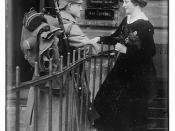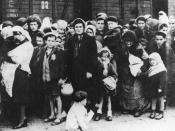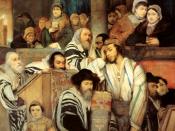The Second World War was over and the Jewish survivors came out of the concentration camps and their hiding - places in the year 1945. Most of the survivors had the conviction that the dimension of the crimes had put an end to anti-Semitism in both German states. However the reality looked different: In the first decade of the post - war period in Germany, a virulent anti-Semitism in society as well as in politics existed in both German states.
The average reaction of society and of the representatives of the bureaucracy towards the Jews was incurious. The German population acted in an extremely hostile manner towards the Jewish people, who had to suffer besetment, deportation, exile and assassination of their families. The suffering of the non-Jewish society due to the war was of far more interest for the German population than the happenings in the concentration camps. The suffering of the victims of the war and of the veterans overlaid the suffering of the Jewish victims.
The German population made no more differences between victims and committer.
This essay aims to describe the obstacles to the re-establishment of Jewish life in occupied Germany and to what extent they were overcome. The discussion that follows is broken down into four sections: The first section describes the first years of Jewish life after the Second World War followed by an explanation of the reaction of the German non-Jewish society. The next section declares the changes which took place in the political system towards the Jews in both German states. The closing observation presents ???????.
In the year 1945 approximately 200,000 Jews remained in Germany. They were mainly from Eastern Europe. The number of Jews who had lived in Germany during the Second World War was between 15,000 and 20,000.
The vast majority of the survivors received the status of "displaced persons". The category of displaced persons included former concentration camp inmates, prisoners of war and all the non-German persons who had fled or were driven from their homes.
These displaced persons had to live in camps and under surveillance of the Allied Forces.
The camps were surrounded with barb wire and watch towers. The displaced persons were not given any sense of liberation. Many inhabitants were reminded of their physical and spiritual experiences, which had a rather negative impact on the social standards in the camps. It was not until Eisenhower acted to remove the barb wire and to move the Jews into several camps that the situation changed in a positive way.
The Jewish survivors represented only a small group of displaced persons.
The Jewish people in the displaced person camps used the camps "to live in their old traditions, to speak Yiddish and to turn the camps into cultural centres with active religious lives" (Juliane Wetzel "Jewish Survivors in Germany after 1945" p.132).
In the following years the military government of the Allies adopted a positive treatment of the Jews. The major goal was to change the anti-Semitic attitudes of the non-Jewish displaced persons. Following the positive changes the government in Bavaria for example established the "state commission for the care of the Jews". Its task was to help the Jewish population and to re - integrate them into the German population.
The vast majority saw their stay in Germany only as an intermediate stop. Most people were merely waiting to emigrate to America or Palestine. However the emigration to Palestine remained largely a dream for the majority of Jews. Only after state Israel had been founded in 1948 could most Jewish people make their way to the new Jewish State. After the liberalization process of emigration to the United States the Jewish people whose goal was the United States could leave Germany.
Some Jews who had experienced the liberation by the Allies in 1945 wanted to remain in Germany either to help rebuild the German state or because of a non-Jewish partner. Nonetheless, during the years 1947 to 1950 the number of the displaced persons dropped sharply. In the year 1947 approximately 200,000 displaced persons lived in Germany, while by the year 1950 approximately 12,000 people were left and remained in Germany. This group of displaced persons made their way to the cities to found new Jewish communities, to settle down and to start a new everyday life. From 1945 onwards 51 Jewish communities were found in the four occupied zones. The German Jews began to reorganise in many localities. The example of Munich is typical. While the Jewish community in Munich had approximately 9,000 members in the 1930s, after the war only around 400 Jews remained and tried to re-establish their community. The community was made up not only of so-called "full - Jews" but also Jews from mixed - marriages and others who had converted to the Jewish faith.
The huge number of Jewish emigrants and refugees from Eastern Europe helped the number of municipalities rise. In the year 1952 there were already 70 Jewish communities with 18,000 members in existence. The main task of these communities was to provide Jewish people with dwelling, food supply and clothing.
In the year 1950 the Central Council of Jews was formed. It was created by representatives of the Jewish municipalities of all zones and seen as the main organisation of Jewish life in Germany.
The obstacles to the re - establishment of Jewish life in the first years after the Second World War were marked by the tensions in the displaced person camps between the Jews from Eastern Europe and those who had survived National Socialism in Germany. The eastern European Jews had no interest in their German environment or in integration into German society. They avoided contact with non - Jews as much as possible. These Jews lived strictly according to the rules of Judaism. They spoke Yiddish and made themselves recognisable as Jews.
The eastern European Jews gave the German Jews the sense that they were not acting in a manner befitting to their faith. They felt guilty about having too much contact with non - Jews, this having become evident in the high number of mixed - marriages for example.
The Jews were warned in the camps not to provoke the German population by calling them Nazis or "German pigs" or to show off with luxuries to which the main German population had no access. This appeal brought the government sharp criticism by the allied powers and resulted in even more anti - Semitism rumours in the non - Jewish population.
The new eastern German state was strongly influenced by Stalin and the anti-Semitic policies of the Soviet Union.
Anti-Semitism and fascist activities were officially forbidden. In reality however, anti-fascism and anti-Zionism was propagated by the state in the GDR, the anti - Jewish activities coming to a high point in 1952-3 under the Ulbricht regime. The anti - Semitism which was propagated by the state was the cause of a considerable migration into the West from the GDR. While West - Berlin tried to help the Jews who left the East block, anti - Semitic attitudes became more and more widespread in the population of the GDR.
The small Jewish communities who were left had a "status comparable to that of an endangered species" (Wolfgang Benz "Anti-Semitism and Philosemitism" p. 156): The Jewish people had the right to live in the GDR, as long as they could live with and tolerate the propagated anti - Zionism.
Approximately four hundred Jews lived in 8 communities scattered throughout the state during this time. These Jews were not former displaced persons, in contrast to those in the Federal Republic. They were from mixed - marriages or had survived National Socialism in hiding places with the help of non-Jewish people.
One of the main difficulties in re-establishing Jewish life in the GDR was due to the tension between religion and the newly formed political system. Many people responded to the demand of the SED to break off all contact with Jewish communities, influenced by the Stalinist policies of the 1950's. The Jews paid for everything they received from the state with "their good conduct and tolerance for the vehemently hostile propaganda against Israel" (Wolfgang Benz "Anti-Semitism and Philosemitism" p. 157).
The problem facing political representatives in the GDR in dealing with the Jews was concentrated on three different groups: the Jews who lived in the GDR, the state Israel and the American Jewish organizations. Another focal point was that of the question of reparation towards the Jews and the crimes which had been committed in the period of National Socialism.
Unlike the Federal Republic the GDR made no efforts to pay restitution or reparations.
The tension between the Jewish survivors and the population in the Federal Republic was different than in the GDR.
The western population hoped to put an end to their responsibility for their past with the closing of the crime trials in Nürnberg. However a second type of anti - Semitism arose. It was connected to the question of guilt and responsibility for what had happened during the era of National Socialism in Germany, especially in Auschwitz. A lot of German people denied that they knew what was happening in the concentration camps. The average opinion was that the Jews made the stories up by themselves and also that there was too little concern about what non-Jewish people had suffered during the war.
"For this reason, the saying, "The Germans will never forgive the Jews for Auschwitz," expresses the core of the problem" (Juliane Wetzel "Jewish Survivors in Germany after 1945" p.136).
A couple of years later the new government of the new German Federal State realized that the re - establishment of Jewish life in Germany was the probation of the new democratic State. The Federal Republic tried to help the new formed Jewish communities rebuild synagogues and provide homes and other assistance for the Jewish members.
Simultaneously a lot of former Nazis got their second chance in the bureaucracy, in the army and in the judiciary system.
The public opinion in the Federal Republic about Jews remained rather negative. A survey in 1952 revealed that 34 per cent of the population still held anti-Semitic attitudes. A wave of anti-Semitic attacks followed. The synagogue in Cologne was desecrated in the year 1959 and this wave of violence washed over to the GDR, especially in the cities of Magdeburg and Leipzig, increasing rapidly in both German states.
Several Jewish cemeteries and synagogues were attacked throughout both German states. Despite protests from the Central Council of Jews, the perpetrators were not seriously pursued by either government. They feared that this would merely attract unwanted attention and thus serve to increase the violent activities.
The presence of the Jews served to remind the population of their past and their guilt, although anti - Semitism was not dependent on the actual presence of Jews.
In the year 1949 after the Federal Republic of Germany was founded Chancellor Konrad Adenauer announced the readiness of the German population to begin paying adequate reparation to both the Jewish victims and the state Israel. The first direct step was made in 1951 by Konrad Adenauer with his speech in the Bundestag, in which he officially apologised for the crimes committed by the Nazi regime against the Jews in the name of the German people. However the state Israel was not yet ready for this approach.
As the importance of the Federal Republic increased in the international geopolitical system, the state Israel became aware of the importance of negotiation between the two countries in the 1950s. However the Federal Republic held back at that time, as some of the Arab states had threatened West Germany not only with an economical boycott but also with the fact that they would then recognise the GDR.
Diplomatic negotiations finally started in March 1960, when Adenauer met with David Ben-Gurion in New York. However, they did not come to a serious end until May 1965 and dialogue between the states remained erratic for some time.
In spite of the diplomatic efforts of the Federal Republic and Israel the massive problems between the Jews and non - Jewish Germans were still far from being at an end.
The Jews felt themselves locked into a circle of problems. They felt they had to justify themselves to fellow Jews living in other countries because of their decision to stay in Germany. They also had to face personal problems due to the attacks which were still being carried out in Germany.
After the desecration of the Cologne synagogue, the first positive developments in the educational system were made. Schoolbooks were revised and the chapter of anti - Semitism became a topic for itself in the curriculum. Nonetheless it took longer for sufficient changes to come into effect. For example the topic of the Holocaust was not adequately dealt with until after the Yom Kippur war had taken place in 1973 and the broadcast of a television series "Holocaust" in 1979 highlighted the issue.


